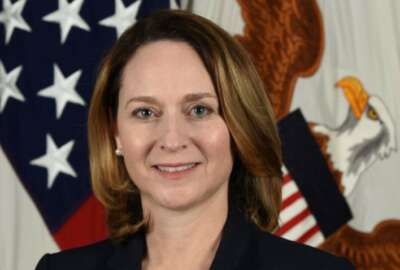Pentagon to reshuffle leadership roles for AI, data, digital services
The plan would create the new position of Chief Digital and Artificial Intelligence officer starting next February, bringing together three of the Office of the...
The Defense Department is planning to shake up the administrative structure of three of its top information technology leadership offices, while putting a new, yet-to-be-named official in charge of all of them.
In a memo Wednesday, Kathleen Hicks, the deputy defense secretary, ordered the creation of a new post called the Chief Digital and Artificial Intelligence Officer (CDAO). Detailed plans for the new office haven’t yet been finalized, but by next February, DoD expects it to encompass the current Joint Artificial Intelligence Center (JAIC), the Defense Digital Service and the Chief Data Office in one form or another.
The new office will subsume the JAIC entirely, becoming its “successor organization,” according to the memo. Meanwhile, DDS — which until now has reported directly to the Secretary of Defense — will report through the CDAO instead. And the CDO, which by law is part of the CIO’s office, will be “operationally aligned” to the CDAO.
DDS in particular has long prized its relative independence from other DoD bureaucracies, with its leaders tending to believe the office’s direct reporting relationship to the secretary’s office is a key part of what’s let it conduct projects quickly.
But the Pentagon insists the move to stand up the CDAO is not intended to create another traditional management bureaucracy. Instead, it’s meant to better integrate the work each individual office is already doing.
“Rather than thinking about it as a management layer, we’re thinking about it as a shift in organizational construct,” said a senior Defense official who briefed reporters on the plans on condition of anonymity. “We’d created the CDO and the JAIC and DDS in a way that each was operating independently — as if the others don’t exist. That causes two kinds of inefficiencies. One, it means we don’t have the kind of integration across their lines of efforts that we could to really maximize the impact. And two, it means we don’t take advantage of when there are overlaps or underlaps in what they’re doing so that we can drive the right kind of prioritization in these spaces.”
Hicks put one of her senior advisors, James Mitre, in charge of drawing up detailed plans to stand up the office. It’s expected to reach initial operating capability on Feb. 1. But before it reaches final operating capability, DoD also intends to ask Congress for legislative changes to create “cleaner” lines of authority for the new organization.
The department doesn’t plan any immediate changes in the leadership of the JAIC, DDS or the CDO. As for who will be appointed to be the new CDAO, the Pentagon says it’s looking at candidates both inside and outside government, and hasn’t yet decided whether the new official will be a military officer, a political appointee or a career official.
“We’re looking for the right leader to drive the kind of progress we want,” the official said. “In practice, that means we’re looking inside and outside of the department, and talking to AI leaders and experts as well. As we work through developing the implementation plan and going to IOC and then to FOC, we’re hoping that collaborative process helps us identify — in a sort of form follows function way — the right kind of senior leader to drive progress.”
The appointment of a new senior official with a direct line to the secretary would also represent yet another change to the centrality of the DoD CIO and that office’s roles and missions. But the CIO’s office is very accustomed to those sorts of changes by now.
In the past decade, the CIO has gone from being a Senate-confirmed assistant secretary of Defense to losing the assistant secretary title, and then reverting back again to a confirmed position (but without the assistant secretary title).
In a more recent example of change, the compromise 2022 Defense authorization bill, released this week, would put the CIO back in charge of Defense business systems – only three years after Congress stripped those authorities from the CIO and gave them to the now-defunct Chief Management Officer. The same bill expresses doubts about whether the office has the expertise to hang onto one of its other current roles: managing DoD’s electromagnetic spectrum.
The 2020 Defense bill also gave the CIO purview over DoD’s chief data office, a role now held by David Spirk. It’s not yet clear whether DoD will ask Congress to move the CDO to the new CDAO office as part of the legislative proposal it’s planning, but the Defense official who briefed reporters hinted it’s likely.
“The digital and technological space is expanding over time, and rather than housing the expansion of disparate requirements and capabilities all within a CIO, we’re trying to keep the CIO doing what the CIO does,” the official said. “The CIO in this case will be a key partner and capability provider to the CDAO, but the CIOs office will remain focused on its core mission of cyber and our IT infrastructure. This new office will be focused more on the digital and AI innovation pieces, and that’s really a wholly separate function. That is very much the standard in industry – having data, analytics, AI pulled out of the CIO’s office.”
Copyright © 2025 Federal News Network. All rights reserved. This website is not intended for users located within the European Economic Area.
Jared Serbu is deputy editor of Federal News Network and reports on the Defense Department’s contracting, legislative, workforce and IT issues.
Follow @jserbuWFED







